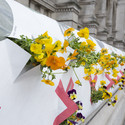
The Victoria and Albert Museum (V&A), named after the Queen and Her Consort, has its foundations in the Great Exhibition of 1851 amidst the wealth, innovation and squalor of the Industrial Revolution. Britain was flooded by prosperity which allowed for the development of major new institutions to collect and exhibit objects of cultural significance or artistic value. The institute’s first director, Henry Cole, declared that it should be “a schoolroom for everyone,” and a democratic approach to its relationship with public life has remained the cornerstone of the V&A. Not only has it always been free of charge but it was also the first to open late hours (made possible by gas lighting), allowing a more comprehensive demographic of visitor.
Their latest exhibition, which opens today, seeks to realign the museum’s vast collection and palatial exhibition spaces in South Kensington with these founding concepts. The interventions of All of This Belongs to You attempt to push the V&A’s position as an extension of London’s civic and cultural built environment to the fore, testing the museum’s ability to act as a 21st century public institution. To do this in London, a city where the notion of public and private is increasingly blurred, has resulted in a sequence of compelling installations which are tied together through their relevance either in subject matter, technique, or topicality.

The presence of the V&A on the streetscape is profound. Standing before its main entrance, its façade appears to stretch far into the distance either way, blending into the Natural History Museum in one direction and staggering down into rows of terraces in the other. Here, however, is where the first of the interventions as part of All of This Belongs to You is located.
Natalie Jeremijenko is the founder of the Environmental Health Clinic at New York University. For her project, which spans both science and public art, she has placed 'AgBags' - advanced grow bags of her own invention - on the large stone parapets at the entrance of museum. Her installation takes existing inner-city structure to create arable territory - almost out of thin air. These porous bags, made out of a synthetic felt called Tyvek, allow the compost within to breath while remaining watertight. Their counterbalanced design allows them to be draped over any kind of railing or façade; the V&A’s front balustrade being the latest metropolitan test site.
Yet, this begs the question: what do you grow on a busy London street? Jeremijenko argues that “most enthusiastic urban gardeners think agriculture is about vegetables.” Here she is proving that this couldn’t be farther from the truth. Flowers, which have both a high nutritional and commercial value, are also important pollinators. “Although highly perishable,” Jeremijenko notes, “flowers are the most nutrient dense things we know of” and are especially important for the ecology of the urban habitat in a pollen crisis. She acknowledges that within the city “there is a whole cultural challenge about how you keep, integrate and incentivise flowers,” and these interventions are part of a global study. Alongside this, she has placed a Phenological Clock in the grand entrance of the museum, it’s face depicting twelve months in the life-cycle of the flowing plants and pollinating insects that surround the building.

The Cast Courts of the V&A are some of the most magnificent spaces within the museum. Put simply, they are enormous vessels of 1:1 plaster models and reliefs of the ‘greatest hits’ of the Grand Tour, all assembled in one place. Not only does this part of the collection directly reference the broader democratic vision of the institution itself, but it also marks the foundation of the museum’s extensive architecture collection which originally began as a full-scale teaching aid and is now the largest in the world. Here, All of This Belongs to You diverts from urban ecology to conservation and preservation in the form of Jorge Otero-Pailos’ ephemeral 'ghost column'.
The largest piece in the Cast Courts is a replica of Trajan’s Column (AD 113), painstakingly reproduced by artisans in Rome before being transported and erected in two parts back in London in the mid-19th century. Due to their size, and in order to stand upright, they were attached to a brick chimney which has been unseen - hidden within the plasterwork - since 1867. Curator of Contemporary Architecture and Urbanism Rory Hyde invited Otero-Pailos, a professor at Columbia’s Graduate School of Preservation and Planning (GSAPP), to reveal the hidden structure using a method which he has experimented with before.
'Conservation Latex' was applied in liquid form to the inner curved wall of the chimney structure. It was then allowed to dry before being carefully removed. This vast piece of plastic fabric has now been suspended and, in so doing, revealed the concealed brick structural interior of the adjacent plaster column. Here, in one object, three moments in time have been aligned in a contemporary continuity between the original column, the plaster copy, and this ‘new’ surface of accumulated dust and pollution.
For Hyde, this intervention in particular speaks of the intrinsic duty of care a museum has to its collection. “If All of This Belongs to You," he says, "then we better look after it." "On the one hand [the museum] needs to keep these things physically intact, but if they’re not relevant or central to thinking anymore then they become fragile in another way: they become easy to get rid of because they’re not important to us anymore.” He talks about this as being a form of ‘conceptual conservation', reanimating the Cast Courts by reintroducing new ways of thinking about the objects. The plaster casts “are reminiscent of a period of time when authenticity was not important. Here, we’re trying to highlight the artifice, while also trying to reclaim some of the relevance.”

The potential imbued in this approach is revealed most clearly in Ways to be Public, an exhibition of drawings, photographs and images chosen and assembled by Hyde himself. It begins with the assumption that public space is in some form of crisis - that our traditional attachment to the public square, the community green, or common land has been eroded. “Largely because of the technology of the 20th century,” Hyde states, “our traditional connection to a specific place or community is no longer as critical as the different networks that we can build independent of that.” Architects, whose job it is to provide meaning through space, have responded to this shift in different ways; the aim of this exhibition is to unpick and gather together the tactics being used and the kinds of new spaces being created.
Among images like OMA’s Flag for Europe (2001), which distends every European Union flag into a sliced barcode of different nation identities under one graphical umbrella, and photographs of the land above the Large Hadron Collider which straddles the border between France and Switzerland, the theme becomes evident. On a variety of different scales - from the continent to the neighbourhood and everything in-between - it becomes apparent that the question of public space is a deeply political one. Trevor Paglen’s photographs of the NSA buildings in Maryland speak of the sinister side to the invisible networks that we have embedded into our daily lives, while Henrietta Williams' visual studies of London’s ‘ring of steel’ allude to the physical manifestation of this threat, subsequent fear, and inevitable attempts at urban control through the seemingly innocuous devices of ornamental pools and trees.

Also indicative of this idea are two drawings, positioned opposite one another. One, a 1:10 reflective ceiling plan of David Chipperfield Architects’ Neues Museum in Berlin, is marked with hundreds of scribbles and notations. Conservators, heritage advisors, architects, and engineers, have each incrementally described which pieces of the building to restore, which to protect, which to replace, and which to improve structurally. This is compared to drawings of Mies van der Rohe’s Neue Nationalgalerie (of the same city), in which a bold new architectural typology was employed to attempt to redefine a nation. As Hyde puts it, “one is essentially an empty container for the public to fill and define their future; the other seeks to do the same through thousands of different tiny decisions. Both are trying to create new beginnings while wrestling with the psychological and physical damage of the past.”
Hyde points out a small printed document from 1682: a mandate from the reign of King Charles II reestablishing the independence of the City of London as a trading place. “It’s a piece of paper which has radically changed architecture - I see it as a bottleneck of history.” In a similar vein, this collection concludes with a photograph of Julian Assange (WikiLeaks) speaking from the balcony of the Ecuadorian Embassy. “He’s physically in reach of the police,” Hyde notes, “but made immune by this piece of architecture where real space intersects with diplomatic law.”
Pieces of Assange’s MacBook, which were leaked to The Guardian newspaper before being symbolically destroyed by the British government, are now on display in Ways to be Secret (curated by Corinna Gardner). From Hyde's point of view, the events that surround this object should also be described as a bottleneck of history. By exhibiting objects such as this, the V&A are actively cultivating a formalised discussion through the lens of the museum’s collection. Hyde continues: “somehow this whole thing is about networks - the idea of the leak, and the power it can have in transforming the city and the world. We’ve placed [the photo of Assange] here - without judgment - as a sort of ‘full stop’.”


Other elements on display include muf architecture / art’s project titled More than one (fragile) thing at a time. They will host a series of activities, all provoked by the existing contents of the gallery and the afterlife of the places those objects came from. In addition, twenty five Civic Objects have been placed around the V&A that relate to the theme of the exhibition. From a security bollard used in the 2012 London Olympics, to anti-homeless spikes embedded between two columns, these objects seek to illustrate the close relationship between design and public life.
Find out more about the exhibition here. The V&A is open daily from 10.00 to 17.45 and until 22.00 on Fridays.






